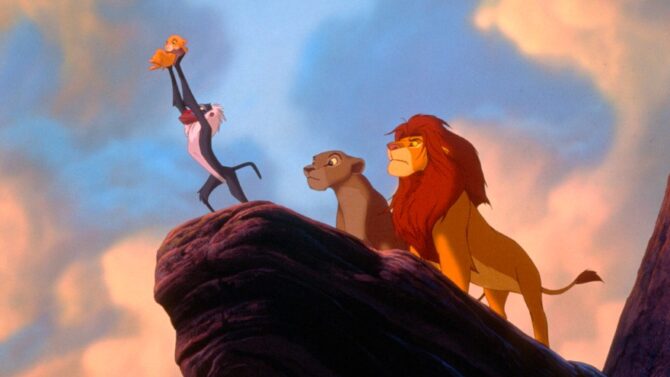The Lion King movie was first released in 1994 and has been a sensation ever since, achieving any legendary status a movie can achieve.
It has since inspired some new works, including a remake in 2019. With a prequel coming in 2024, we haven’t seen the last of the animated movie yet.
There were many sensational aspects — including the vast array of animals in Lion King that filled the screen and melted our hearts.
Set in Africa, this movie met the expectations of many animal enthusiasts with the wildlife display.
We all remember the main characters and the many supporting characters that gave color to the scenes.
Some of The Lion King’s animals include lions, meerkats, wildebeests, warthogs, elephants, and even the unusual mandrill.
Let’s go into the details. We will first look at the main characters from the cartoon, and then explore them in their real life.
Fun Fact: The initial idea for “The Lion King” was very different from the final product. It was originally titled “King of the Jungle” and was supposed to be a more serious drama without songs.
The Popular Animals in Lion King Movie You Probably Didn’t Know
The first part of the list is dedicated to the main characters, including the lion, meerkat, warthog, mandrill, hyena, and hornbill.
1. Lion
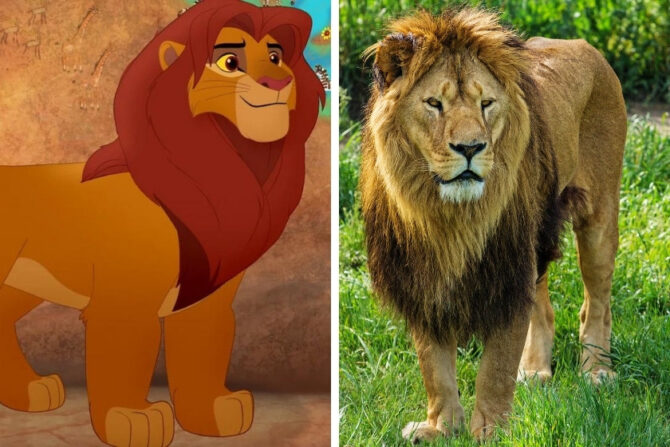
In the movie:
Lions take up center stage both in this animated movie and in the sequel.
The movie gets a lot right about these creatures, from the use of “the pride” to the lionesses being the warriors.
Of course, it would be hard to imagine a small cub befriending a meerkat and a warthog, but unusual happenings make any movie worth the watch.
Examples of lions in the movie are King Mufasa, his brother Scar (the antagonist), Simba, Nala, and Sarafi.
In Real Life:
The lion is called the King of Animals because of its strength and apex predatory status.
It fears no one, including humans, though it can be opposed by animals like the hyenas (which fits into the movie).
Lions belong to the Felidae (cat) family, making them a relative of your kitten at home.
This is the only social cat in the animal space, and a group of lions is called a pride.
The latter must have inspired Pride Rock. Lions are currently vulnerable, according to the IUCN red list.
2. Meerkat
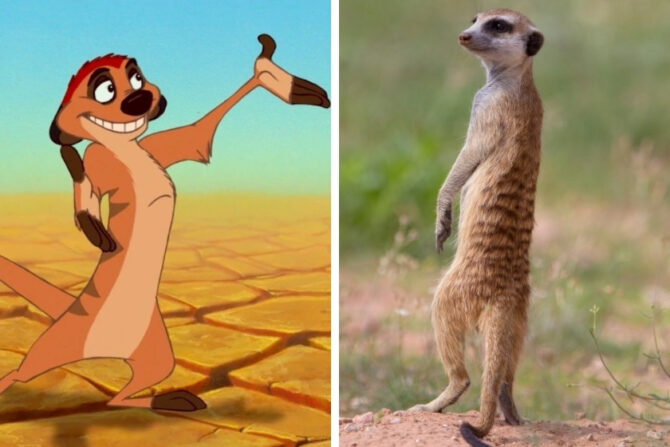
In the movie:
The meerkat in the movie is named Timon, and he is essential to the plot. His best friend is a warthog called Pumbaa, and together they add humor to the movie.
They find Simba when the latter is exiled and left to die in the open and stop vultures from having their way.
Timon and Pumbaa are credited for the song Hakuna Matata, and they get a series of their own. They are also the main characters of The Lion King 1½.
In Real Life:
There are many differences between Timon and a real-life meerkat. Meerkats don’t talk, for starters.
They also don’t walk on hind legs but rather move on all fours—though they can stand on hind legs.
The meerkat is a small mongoose found in southern Africa.
Its main physical features include large eyes, a standing tail, and a coat that’s both light grey and yellowish brown. It adapts well to dry habitats, is very social, and is diurnal.
Interesting Fact: The story of “The Lion King” draws inspiration from various sources, including William Shakespeare’s “Hamlet” and biblical tales like Joseph and Moses. It also incorporates elements of traditional African culture and wildlife.
3. Warthog

In the movie:
The warthog’s name is Pumbaa, a fat creature known for his flatulence. He’s a friend of Timon, and together they help the main character Simba.
Pumbaa’s name is derived from Swahili, and it means “to be foolish, silly, weakminded, careless, negligent.”
He seems like a coward from the start but later displays courage at the end. He also has an aversion to the name “pig.”
In Real Life:
The Warthog is less pleasant to look at than its animated depiction in Pumbaa.
Also, despite the hatred Pumbaa has for being called a pig, the warthog belongs to the pig family known as Suidae.
It is a native of Sub-saharan Africa, where it lives in grasslands, savannahs, and woodlands.
The warthog does eat insects like Timon and Pumbaa, but it isn’t restricted to being insectivores. It also feeds on fruits, roots, berries, fungi, and carrion.
4. Mandrill
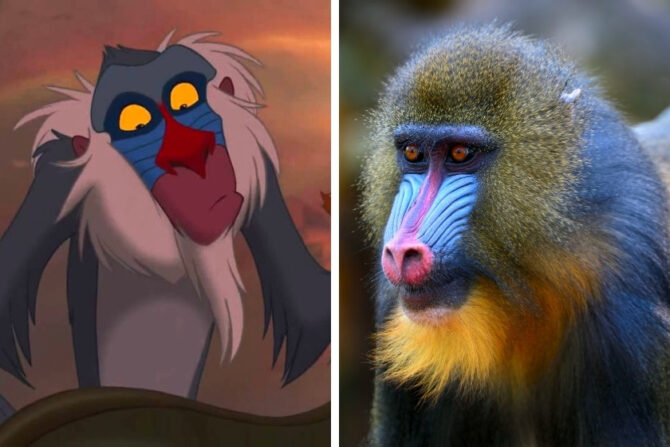
In the movie:
The shaman Rafiki is a mandrill and serves multiple roles, including being the King’s chief adviser.
He’s one of the first major characters you’d notice as he’s seen in the beginning, lifting the baby prince Simba to the view of the animals.
Rafiki is portrayed as both wise and a bit eccentric, and he seems to be an artist as well, judging from the way he uses colors.
Because he’s old and acts as an oracle of sorts, people listen to his advice. He’s one reason Simba returned to reclaim his land from Scar.
In Real Life:
The mandrill doesn’t speak, but its physical features are similar to the animated version.
It is one of the most colorful mammals, with red and blue colors on the face and posterior.
The mandrill was once considered a baboon, but further studies have distinguished it.
Mandrills can be found in tropical rainforests and sometimes around savannahs, which explains the favorite hangouts of Rafiki.
It feeds on leaves, piths, mushrooms, insects, and even younger antelopes.
Interesting Fact: “The Lion King” was one of the last major Disney films to use traditional hand-drawn animation, employing over 600 artists, animators, and technicians during its production.
5. Hyena

In the movie:
The hyenas were presented as enemies of the lion, fully in line with the natural enmity that exists between both animals.
They didn’t live in the pride lands but were conserved to the outlands.
The first time we see the hyenas in action is when they accost Simba in the Elephant Graveyard. They also ally with Scar in his coup d’etat.
Hyenas are known as talkative, mischievous, and a bit sadistic. The names of the three hyenas are Shenzi, Banzai, and Ed.
In Real Life:
Hyenas, in reality, are much like the animated series. They are social animals with an alpha female, characterized by Shenzi in the movie.
Only four extant species are left, and they can be found in Africa.
Hyenas are mainly scavengers, but they are known to hunt down prey when they can find them. They also feed on fruits and may sometimes eat insects.
These wild dogs are very vocal, and yes, they do laugh. They also make other sounds like grunts, groans, whining, and yells.
Interesting Fact: The portrayal of hyenas in “The Lion King” was criticized by some biologists, who felt it misrepresented these animals as villains, contributing to their negative image.
6. Hornbill
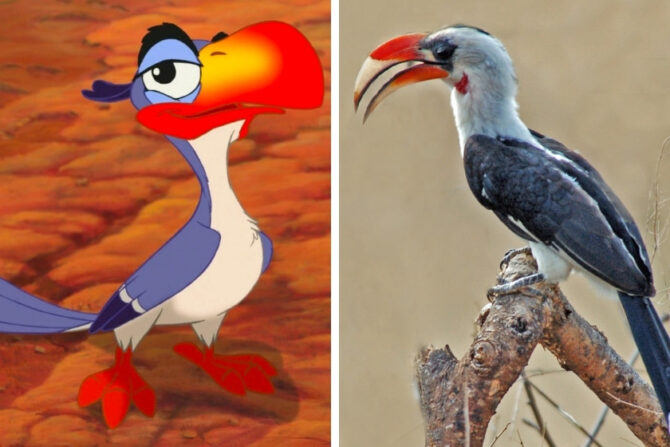
In the movie:
The hornbill is named Zazu, and he is the steward of the royal household as well as the personal assistant of the King.
He was also the friend of the late King Mufasa and is depicted as an uptight bird who took his job a little too seriously (though, unfortunately, even the little cubs didn’t take him seriously).
He proves to be very loyal to Mufasa, even after the latter’s death. He is recognized by the red-colored hornbill.
In Real Life:
The hornbill is a family of birds that can be found in Africa, Asia, and a part of Oceania.
Just like Zazu, the biggest physical trait of the hornbill is the long, down-curved bill, which comes in different colors.
There are different hornbill species, each with their size. The African species aren’t being threatened, but those found in Asia face dangers due to hunting and habitat loss.
The second part of the list of animals in The Lion King is the supporting characters, including the African elephant, giraffe, wildebeest, zebras, black rhinos, crocs, and many more.
7. African Elephant

In the movie:
The African elephant was part of the general population, and none of the main characters was an elephant.
Elephants did grace many important scenes, like the presentation of Simba as a cub and of Simba’s daughter.
They were also present in the musical sequence of “I Just Can’t Wait to Be King” and “Hakuna Matata.”
The setting where the young Simba and Nala meet the hyenas is called Elephant Graveyard.
In Real Life:
Elephants in the movie didn’t speak, though they joined in the singing. Thus, there are no noticeable differences between the animated versions and the real-life animals.
Both share the characteristics we know elephants for, like the trunk, tusks, and huge size. They also make the same vocal sound.
Elephants remain the largest living land animal, and only three species are still left.
These are the African bush elephant, the African forest elephant, and the Asian elephant. The elephants in Pride land were of the African variant.
8. Giraffe

In the movie:
Giraffes are also a part of the Pride land population, and no main character is a giraffe.
They did make some significant appearances and gave the movie the African flavor the producers no doubt intended.
There were giraffes present during Simba’s presentation, and the “I Just Can’t Wait to Be King” scene.
They also appeared in the “Hakuna Matata” scene and were present in the presentation of Simba’s cub.
In Real Life:
The giraffes in the movie are similar to those of real life, complete with long necks, yellow spotted skin, and herbivorous habits.
There are currently eight extant species of giraffe. All of these were once considered subspecies, but that changed after further research.
There are also some extinct species, numbering up to seven.
The giraffe is considered Vulnerable by the IUCN. This is due to factors like predation from other animals and hunting.
Giraffes are currently being kept in parks and reserves, though there is still a stable population in the wild. You can find them in Africa.
9. Wildebeest
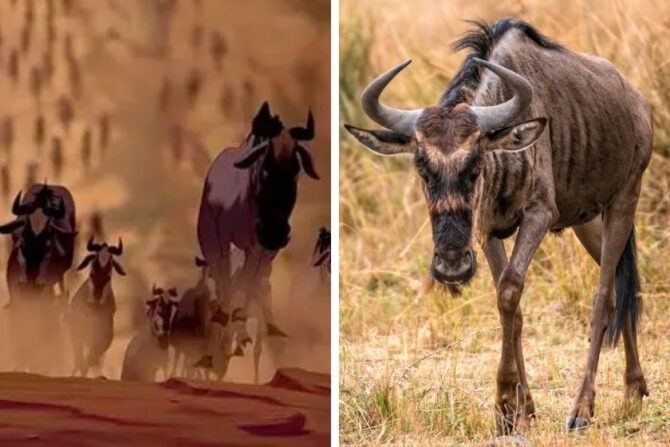
In the movie:
Many fans of The Lion King animated movie would remember the Wildebeest, not because there was any main character attached to the name, but because they were pivotal in heightening the conflict and changing the course of the plot.
When Scar plots to overthrow Mufasa with the hyenas, their plan involves triggering a wildebeest stampede.
Unfortunately, they were very successful. Wildebeests also appeared in the presentation of Simba.
In Real Life:
Wildebeests are just as disruptive in real life as they were in the movie, but only when they are perturbed.
Otherwise, they are simply big herbivores that prefer staying on their own.
They reside in Africa, where they can be found in habitats like plains and open woodlands.
There are two species, the blue wildebeest and the black wildebeest.
Wildebeests serve a lot of purposes in humans. The hide can be used for leather, while the meat serves as food.
However, the wildebeest isn’t in any form of danger. Both species are considered Least Concern by the IUCN.
10. Zebra
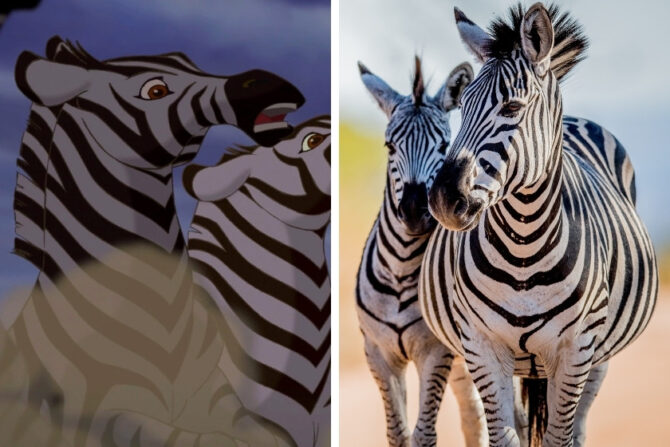
In the movie:
Zebras don’t play any role in a vital scene, and their only full appearances are as add-ons.
The first time was during the presentation of Simba as a cub, and the second was when Simba became the king and presented his cub.
There was also a glimpse of them during the “I can’t wait to be king” moment. They appeared more in the sequel Simba’s pride and the prequel.
In Real Life:
There are no noticeable differences between the animated zebras and the real ones. All zebras look like donkeys, except they have white coats and stripes.
Efforts to domesticate them have largely been futile as they tend to retain a wild nature.
However, they aren’t considered dangerous as they are herbivores and more prey than predators.
11. Black Rhinoceros
In the movie:
The black rhinoceros appears in some memorable scenes, the first of which is “The Circle of life” musical sequence, when a rhino’s rising head appears for a short moment.
There are also glimpses of it in the scene of “I just can’t wait to be king,” especially when one sits on Zazu.
In Real Life:
The black rhinoceros is one of many rhinoceros species, numbering up to five.
It is native to eastern and southern Africa, where it inhabits grasslands, tropical bushlands, and savannahs.
Not all black rhinoceroses are black, though. Some are colored grey.
The black rhinoceros is critically endangered because of threats like habitat change, illegal poaching, and competition from other species.
Some subspecies of the black rhinoceros have already been declared extinct.
12. Crocodile
In the movie:
The crocodile is found both in the outlands and the pride lands, and it is colored either grey or green.
They are quite common in both places, even appearing in one of Zazu’s reports thanks to the turbulence they seemingly caused.
They also appear during the “I just can’t wait to be king” scene with a host of other animals.
Another instance is in Simba’s Pride, the attack on Simba’s daughter Kiara and Kovu in the Outlands.
The only noticeable crocodile character appeared in The Lion Guard. He’s an antagonist named Makuu.
In Real Life:
Some of the crocodiles in the movie look too cartoonish when compared to the real-life version.
However, the picture is relatively accurate, especially the jaws and teeth. There are many crocodile species, with some being in Africa. They are apex predators and very deadly.
These animals can attack humans even without provocation.
As apex predators, crocodiles are generalists. They feed on a variety of prey, including different species of fish, reptiles, birds, and mammals.
They employ a lot of ambush and agility when going after prey.
13. Cheetah
In the movie:
The cheetah makes an appearance both in the first movie and subsequent ones.
These animals attended Simba’s presentation and took part in the “I just can’t wait to be king” scene.
They also participate in the exile of Kovu in Simba’s Pride, and on the Lion Guard, one of the characters is named Fuli.
In Real Life:
The cheetah is a large cat that’s native to both Africa and Asia. While there are similarities between the animated cheetahs and the live version, the latter doesn’t look as harmless as Fuli.
It is a strong carnivore and very fast, being the fastest land animal currently existing. There are four extant subspecies.
Compared to other wild cats, the cheetah is timid. It can be easily tamed, and there have been different cases of this happening.
Due to different factors like diseases and cannibalism, the cheetah is considered Vulnerable by the IUCN.
14. Gazelle
In the movie:
The gazelle is one of the first animals you see at the start of the movie running through the wild as they assemble at pride rock for the presentation of Simba.
Besides moving in tune with the song and appearing in some other scenes, gazelles play no vital role in the advancement of the plot. They are more seen in The Lion Guard.
In Real Life:
The gazelle falls under the genus Gazella, which can be found in deserts, grasslands, and African savannahs.
All gazelles are considered antelopes, but as we’ll soon see, not all antelopes are gazelles.
These animals are known for their speed, going as fast as 100 km/h. This helps them evade predators and have eyes at the sides to pick up any stalking predator.
Gazelles are herbivores, feeding on the vegetation around their habitat.
15. Antelope
In the movie:
There are many antelopes in Pride Land, and there are different other species other than the gazelle.
This includes the impalas, kudus, oryxes, roadblocks, and the sable antelope. Antelopes were essential when Mufasa explained the circle of life to his son.
His statement is one of the most memorable: “When we die, our bodies become the grass, and the antelope eat the grass. And so we are all connected in the great Circle of Life.”
In Real Life:
Antelope is a broad term that encompasses different species, all with even toes.
They can be found both in Africa and Eurasia, often staying in savannahs.
Every antelope species has legs designed for speed, and they tend to move in long strides. Antelopes are herbivores and ruminants.
Because they are prey, their senses are adapted to getting away from predators living around them.
16. Vervet Monkey
In the movie:
Monkeys could easily be seen in the presentation of Simba as a young cub. They celebrate him with a lot of enthusiasm.
They also appear in Simba’s Pride, only this time for the presentation of Simba’s daughter.
An additional scene is during Kovu’s exile. We see monkeys in other series as well.
In Real Life:
Vervet monkeys are natives of Africa, going by the simple name vervet. There are five existing subspecies, all of which are spread throughout the southern parts of Africa.
These creatures have also been introduced to places like Florida and Cape Verde.
The vervet monkey is mainly herbivorous, feeding on fruits, seeds, leaves, seeds, and pods.
17. Ostrich
In the movie:
Recall the part where Simba and Nala rode on ostriches? That was one of their major appearances.
Of course, like other animals, they also visit Pride Rock for Simba’s presentation and that of Kiara.
They participate in the exile of Kovu too, and they can be seen trying to peck him.
A final appearance of these long-legged creatures is in the “Upendi” scene.
In Real Life:
The ostrich is a formidable, flightless bird of the Struthio genus. It can be described as a ratite bird alongside others like emus, rheas, and kiwis.
There are two species of ostrich still in the world today, the common ostrich and the Somali ostrich.
Ostriches are the world’s largest and fastest birds on land, covering up their lack of flight with speed. They also have the largest egg among birds.
18. Aardwolf
In the movie:
There aren’t many appearances of Aardwolves in the main movies, but they play a crucial role in The Lion Guard series.
When Kion—Simba’s son—accidentally banishes the aardwolves alongside hyenas, the pride land gets overcome by termites. He ventures out to bring the aardwolves back.
In Real Life:
Aardwolves are insectivorous hyena species, which explains Kion’s mistake and why they are suitable for termite control.
They are natives of east and South Africa, and they also go by other names like maanhaar jackal, civet hyena, and termite-eating hyena.
Rather than hunt large animals, they go after insects, mainly termites.
19. Vulture
In the movie:
Vultures didn’t appear in the presentations of both Simba and his daughter, but they clearly showed in both The Lion King and its sequel.
Vultures circle the slumped body of Simba in the desert after the latter escaped pursuing hyenas.
They would have eaten him but for the timely intervention of Pumbaa and Timon.
They are also seen in Simba’s Pride when war is brewing, symbolizing the death that would have occurred.
In Real Life:
Vultures are scavengers, just like the movie shows. They are well known for their bald head, and in many places, the sight of vultures is a bad omen.
There are 23 species of vultures spread all around the world, from Africa to Asia down to the Americas.
These birds of prey rarely go after living animals, though they may feed on injured ones.
20. Termite
In the Movie:
Termites live in both the pride lands and the outlands, where they make a decent meal for many animals like aardwolves.
They didn’t show much in the first movie but had some appearances in Simba’s Pride and other series.
In Real Life:
Termites are worldwide insects, occurring in every continent except Antarctica.
They have a connection to cockroaches, and in real life, they also make a good meal for Aardwolves.
Termites are sometimes referred to as “white ants,” but they have no connection to ants. They live in coniferous forests, hardwood forests, etc.
Final Thoughts
The Lion King and subsequent releases have all been considered big successes, and it’s not hard to see why.
Besides the strong plot, this movie does well with a good setting and a variety of animals, accurately capturing the African wildlife atmosphere.
With the movie Mufasa: The Lion King, set for release in 2024, we are yet to see the last of the pride lands.
